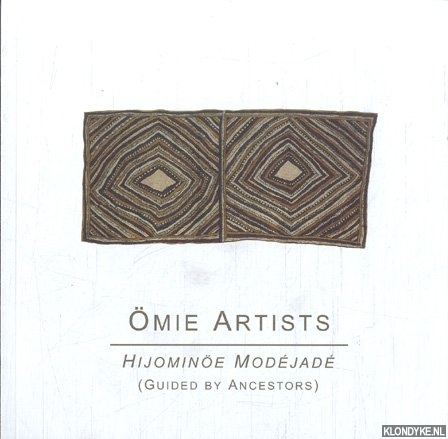
Onze boeken
Ömie Artists. Hijominöe Modéjadé (Guided by Ancestors)
Door Brennan - a.o. King
Categorie | Tapijten & Textiel |
|---|---|
Boeknummer | #234762 |
Titel | Ömie Artists. Hijominöe Modéjadé (Guided by Ancestors) |
Auteur | King, Brennan - a.o. |
Boektype | Paperback |
Uitgeverij | Ömie Artists Inc. |
Jaar van uitgave | 2015 |
ISBN10 | 099430725X |
ISBN13 | 9780994307255 |
Taal | Engels |
Beschrijving | 500 copies. |
Samenvatting | Ömie Artists (Inc.) is a cooperative of Ömie tribeswomen barkcloth painters from Oro Province in Papua New Guinea. Paintings on barkcloth, also known as 'tapa', are the customary textile of the Ömie. Women wear nioge (skirts) while men wear givai (loincloths). Ömie barkcloths are still worn today by men, women and children during traditional ceremonies which can involve feasting and spectacular performances of singing, dancing andkundu-drumming. Barkcloth also serves important purposes in marriage as offerings to the Ancestors, brideprice gifts, as well as in funerary and initiation ceremonies. It is an integral part of everyday life for the Ömie and plays a critical role in defining their unique cultural identity. Women prepare the barkcloth by harvesting th... (Lees verder)e inner layer of bark of rainforest trees which they rinse and then fold and pound repetitiously on flat stones using black palm mallets until a strong, fibrous sheet of cloth is produced. The cloth is then left to dry in the sun. A rich and earthy palette of natural bush dyes including red, yellow, green and black pigments are created from fruits, ferns, leaves and charcoal. Ancient clan designs are painted in freehand onto the cloth or the cloth is dyed in river mud and the designs are appliquéd using a bat-wing bone needle. Common painting implements include strong grasses, fashioned wooden sticks and brushes made from frayed betelnut husks. The Ömie women's paintings are adorned with finely executed motifs and dazzling geometries loaded with tribal and clan-specific cultural knowledge. This organic, abstract symbolism arose from the closely tuned relationship the Ömie have with their natural environment – landscapes criss-crossed with sites of great spiritual significance and inhabited by the spirits of Ancestors. The volcanic mountain, Huvaimo, is the beating heart of Ömie culture. The Ömie Creation story tells of how the first man and woman, Mina and Suja, were created there and the Spirits of Ömie Ancestors reside there. It is the place where Ömie women's barkcloth painting originates – where the first Ömie woman Suja beat the first barkcloth at the river Uhojo. It is a powerful place that is both honoured and feared by the Ömie. In times of storms and floods the Ömie turn to Huvaimo to appeal to their ancestors to quell the punishing weather. There is strict jagor'e (customary Ömie law) that must be followed when approaching the mountain and entering its land. To this day, this sacred country is closely watched over and protected by the Ömie. Artists inherit clan designs as young women by birthright or marriage from their mothers, grandmothers and mother-in-laws, and in some instances from their fathers and husbands. Most designs are generations old but some elderly artists who have attained a level of mastery, usually Duvahe (Chiefs), are free to paint their uehorëro(wisdom), creating new designs. The Ömie's female Chief system is primarily based upon a woman's barkcloth painting talents and the cultural knowledge she attains over a lifetime. All painting designs originate or are derived from traditional Ömie culture and the natural environment, maintaining and communicating artists' deep connection to their Ancestors and country. Ömie territory's lush rainforests, wild rivers, fauna, elemental phenomena and sacred creation sites such as Huvaimo and Mount Obo provide a plethora of subjects from which artists continue to draw inspiration for their painting designs. Certain designs serve the important purpose of upholding Ömie law, passing on essential knowledge such as taboos and educating the next generation about how to protect and preserve sacred sites. The story of the survival of Ömie barkcloth painting to the present day is entirely unique. In 1951 Huvaimo erupted which correlated with the coming of the first missionaries who banned the ancient initiation ujawé rite which involved tattooing sor'e (clan insignia) onto the skin. The Dahorurajé clan Chiefs Warrimou and Nogi believed the eruption was a warning from their Ancestors that reside on the invisible Spirit-village on Huvaimo – a warning that the old ways were being lost and that they must turn away from the outsiders and hold onto their traditional culture. In order to appease the Ancestors, the Chiefs spread word throughout the tribe, encouraging the women to continue painting barkcloth and also to transfer the men's tattoo designs onto the barkcloth. And so triumphantly, the Ömie have managed to preserve their barkcloth painting traditions as well as the ujawé symbolism through the women's art. Of great cultural integrity, the barkcloth art of the Ömie stands as testament to the strength and endurance of their culture, where, through their visually arresting and highly sophisticated designs, we see in full strength the continuity and ingenuity of their ancient yet living artistic traditions. Ömie Artists is fully owned and governed by Ömie people. Five Art Centres service artists across twelve villages and each of the centres play a vital role by ensuring that the ancient tradition of barkcloth painting as well as traditional culture remain strong and by providing economic returns to their artists. Income generated from sales allows artists and their families access to essential services such as hospitals and secondary schools, and necessities such as medicine, clothes and tools for building houses, hunting and subsistence farming that are otherwise unavailable to them in their remote homelands. Ömie Artists' Manager works closely with a Committee of Art Centre Coordinators to facilitate sustainable production and ethical sales of artists' works and to protect the rights of the artists. The Manager and Committee also work in close consultation with Chiefs and elders to ensure that traditional clan copyright laws are upheld and cultural information is verified before distribution. Barkcloth artworks are catalogued and then exhibited internationally with our gallery partners where, upon sale, a Certificate of Authenticity which provides detailed information about the artwork designs and/or story, and an Artist Biography accompanies each work. |
Pagina's | 83 |
Conditie | Goed |
Prijs | € 20,00 |

Onze gebruikte boeken verkeren in goede tweedehands staat, tenzij hierboven anders beschreven. Kleine onvolkomenheden zijn niet altijd vermeld.










